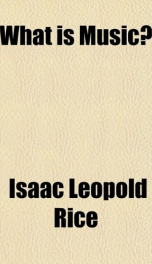what is music

Purchase of this book includes free trial access to www.million-books.com where you can read more than a million books for free. This is an OCR edition with typos. Excerpt from book: n. HINDOO THEORY. The musical system which next claims our attention is that of the ancient Hindoos. Though unlike that of the Chinese, it is no less curious and interesting. The latter attempted to account for the power of music over the emotions by a mystic symbolical system. But it was not the characteristic of the Hindoos to enter into such geognostic mysteries. They, too, were susceptible to the influence of music, and to a very great degree; but they were too indolent to seek for the natural cause of the phenomenonthey had a simpler way of doing things. Why spend your existence in the futile effort to untie a knot, when you can cut it, and sever its most intricate ramifications at a single blow? Music is the invention of the great god Mahada- Krishna, who caused five Ragas to spring from his five heads. The sixth owed its existence to Parbuti. Afterward Brahma himself created thirty Raginits. Each Raga was then personified in a god who protected and governed it, each Raginit in a nymph.The Ragas were the primary modes, the Raginits the secondary ones. Later Sarasvati, the Spouse of Brahma, presented mankind with the most beautiful of instrumentsthe vina. The demi-god Nared was selected to teach its use. Then Mahada-Krish- na endowed the Ragas with the power of magic the Ragas, in turn, endowed the Raginits. Men, animals, and inanimate Nature, were henceforth compelled to obey them. One Raga was possessed of the power of raising clouds and producing rain. A songstress versed in that mode at one time saved Bengal from an imminent famine by intoning it. Another Raga could cause the sun to vanish. One charmed serpents, another lions and tigers. All heaven is filled with music. The great god Indra is surrounded by Ganharves; they accompany him in war, and sing his pra...
Info about the book
Author:
Series:
Unknown
ISBN:
1596154306
Rating:
3.5/5 (2)Your rating:
0/5
Languge:
English
Users who have this book
Users who want this book
What readers are saying
What do you think? Write your own comment on this book!
write a commentGenre
if you like what is music try:
Other books by this author
Do you want to read a book that interests you? It’s EASY!
Create an account and send a request for reading to other users on the Webpage of the book!

